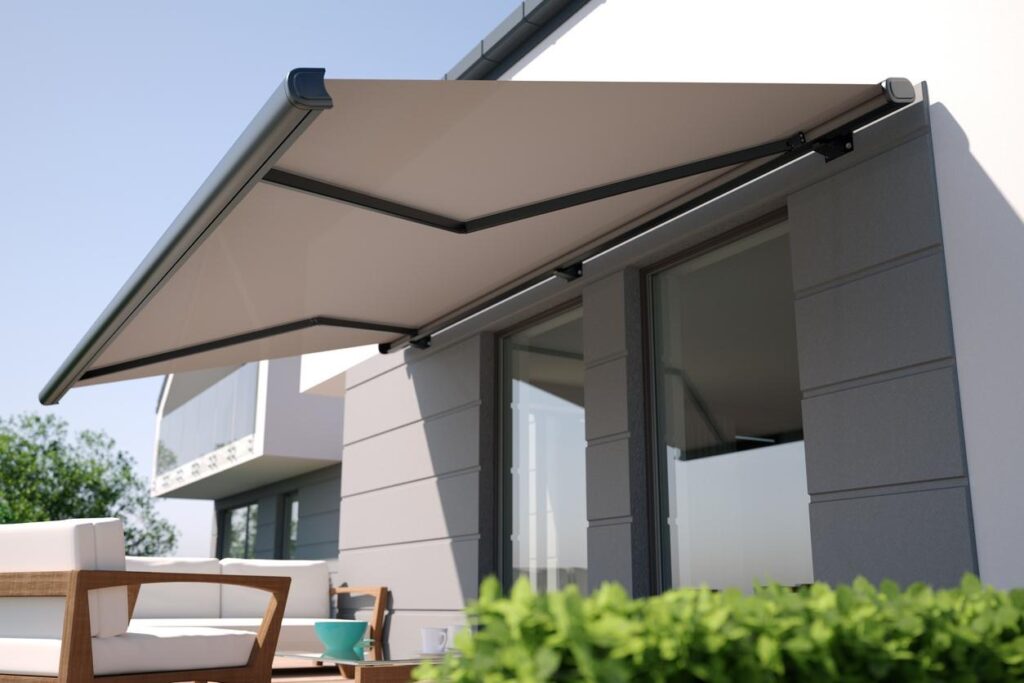Small outdoor spaces often get pushed to the side quite literally. They’re the awkward bits of backyard between the house and the fence, the skinny balcony off the bedroom, or that tight little corner that barely fits a café chair. But just because a space is small doesn’t mean it’s useless.
With the right design choices, especially when it comes to shade, even the tiniest areas can punch well above their weight. Awnings can work wonders, taking a seemingly forgettable patch of concrete or timber decking and turning it into your new favourite spot to chill.
The Awning Advantage: Why Overhead Shade Matters
One of the easiest ways to give a tight space a whole new lease on life is by shading it properly. A well-placed awning defines the space. It gives that little side patio or front landing a sense of purpose. Think of it like adding a ceiling to a room; suddenly, it feels intentional.
But shade does more than protect. It adds comfort, and once you’ve got comfort, you have something worth using—somewhere to enjoy a morning cuppa, read a book, or have a wine in the evening breeze. It softens the harshness of outdoor exposure without enclosing it completely.
Fixed or Retractable? Choosing a Setup That Suits Your Space
Choosing the right awning comes down to more than just style. It’s about how the space functions day to day.
Fixed awnings are ideal when you know exactly what you want covered. Maybe it’s the narrow patio just outside the kitchen that cops full sun at lunch. A fixed awning stays put, offering consistent shelter rain or shine. It’s dependable, low-fuss, and well-suited for static spaces.
On the other hand, retractable awnings let you control how much coverage you want, which can make a tiny area feel far more flexible. If you need full sun while doing the laundry, retract it. Hosting a barbecue later? Extend it for full coverage. This kind of adaptability can make a poky courtyard feel more open simply because you’re not locked into one layout.
Folding arm awnings are a solid pick when you want shade but don’t want bulky poles or posts getting in the way. With nothing touching the ground, these are particularly handy in narrow spaces where every square centimetre counts.
Placement is Everything: Don’t Just Think Overhead
When most people think of awnings, they picture something directly above them. Fair call, but sometimes, the smartest placement isn’t overhead at all.
Take the western sun, for instance. If you’ve got a small outdoor area that faces west, a side-mounted awning can block out that glare without having to fully cover the top. It’s shade where you actually need it, not where you assume it should go.
Design Tricks That Make Small Spaces Feel Bigger
You don’t need more room, just the right tricks to make it feel like you do. When it comes to awnings, the way they look and blend into your space is just as important as how they function. Here are a few tips:
- Light-coloured fabrics reflect heat and bounce light around, making the area beneath feel airier. They also draw less attention to themselves, letting the rest of your outdoor styling shine.
- Minimalist arms and fixtures help declutter the visual space. Clunky hardware can make a small zone feel busy while sleek lines keep things calm and cohesive.
- Blend the awning with your exterior. If it’s in harmony with your home’s existing colour palette and design, it’ll feel like it’s always been part of the plan, not an afterthought.
- Think vertically. Awnings work beautifully alongside vertical gardens or hanging string lights, both of which pull the eye upward and expand the feel of the space.
Multi-Use Goals: Shading, Dining, Lounging
You don’t need a massive backyard to live large outside. With the right awning in place, even the skinniest slice of space can serve more than one purpose.
Picture a folding arm awning stretched out over a little timber deck, with a couple of stools and a compact table underneath. That’s your breakfast nook. Later that afternoon, the same space transforms into your reading corner with a lounge chair and a cushion. By evening, maybe it becomes your pop-up outdoor office for replying to emails in peace. One shaded area, three different moods.
Maintenance and Longevity: Keeping It Simple, Always
Anything left outside needs to earn its keep. That goes for awnings too. Thankfully, most modern designs are built tough and don’t need much more than an occasional once-over.
Go for rust-resistant frames and UV-stable fabrics—that’s your baseline. They’ll stand up to rain, sun, and the occasional wayward ball from next door. If your awning’s motorised, check the moving bits once a month to make sure everything’s gliding smoothly. Dust, leaves, and moisture can muck up the works if left too long.
To truly enhance your small outdoor area, consider collaborating with a professional deck builder who can tailor a design that complements your awning setup. By integrating a well-crafted deck, you can create a seamless transition between indoor and outdoor spaces, maximizing functionality and aesthetic appeal. A skilled deck builder can help you choose materials and layouts that not only fit your space but also enhance the overall ambiance. This approach ensures that your outdoor area becomes a versatile extension of your home, perfect for relaxation or entertaining guests, while also adding value to your property.
In the end, don’t worry about having small spaces to work on. You’ve learned here that that skinny balcony or poky patio can become a quiet escape, a sunny nook, or a breezy lunch spot. All it takes is a bit of know-how and the right shade overhead.



